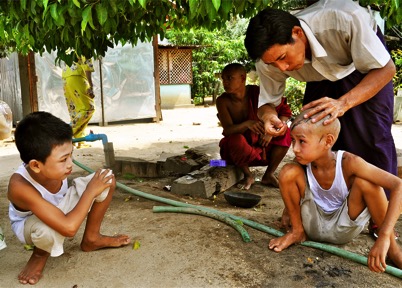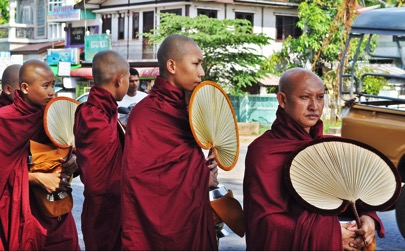
Theravada Buddhism.
Images courtesy of the author.
By Lawrence Lenhart
Figs. 1 & 2 There will be a head-shaving today. Two boys; one must go first. The novitiates must be of a certain age. Some call it thirteen. Some call it ten. Some call it, “Can the child scare a crow?” The boys demur as the adults stand by, making small talk as they await the gridlock to resolve itself. Saying softly: You go first/ No, you—clinging to their hair for a few moments more.
Today has been declared an auspicious day to enter the monastery; a day to follow the path of Buddha’s son, Rahula. Two thousand and five hundred years ago Rahula asked his father for his inheritance. Instead, Buddha sheared his son’s hair and beckoned him into the forest monastery, and Rahula followed without hesitation. Thus began the path of sramanera.
The elder monk, who, with whetstone and strop on a hlu-win, honed the razor and examined its parts—handle, shoulder, back, head, point, edge, blade, heel, shank, pivot, tang—is yawning now in the shade of a tree, patiently rotating the razor, still waiting for the boys to decide who will be first.
The boys are polite to one another as they speak, true partners in this ceremonial tonsure, but each still clings to his hair. Eventually, one agrees to go first. He grinds his teeth as his head is soaked with water from a hose. On his haunches, frowning, his scalp is shorn in front of everyone. Tufts of black hair hallow the sand. Two friends becoming sramanera, following Rahula. Afterwards, they race in the yard, filling it with their joyful cackling. Happy shinbyu, happy shinbyu.

Fig 3. In George Orwell’s Burmese Days, the unscrupulous Burmese officer U Po Kyin intends to rectify his iniquity by spending his capital on a bevy of pagodas. Even after British colonialism in Burma ended in 1948, U Po Kyin’s native greed resonated as the corrupt junta reigned through 2010. Though he dies before the first pagoda ever breaks the tree line, one can see—a hundred steps above the green Bago forest, conflagrated by semal trees’ burst orange-buds—that many others have taken up U Po Kyin’s mantle. Both a memorial and a reliquary, the pagoda is a ubiquitous architecture in Myanmar, which is also known as the “Land of Pagodas.” I sense a pilgrimage that extends along Myanmar’s national borders.
Looking out on the vastness, the gilded spires piercing the canopy, I imagine for a moment that I am alone. On the other side of the gold-flaked and sun-scorched central tower of this pagoda, however, I hear a group of young monks also making a pilgrimage. The child monks drink in the apparent boundlessness of “public.” “Please take mine,” one monk pleads, pointing to my camera.
In their first days away from home they are giddy at the prospect of further dislocation forged by their pagoda ascent. They warble with independence. Having circled the narrow belt around the tower, they look out at a giant Buddha reclined in right lateral-recumbent position. His shoulder bulges above the trees.
After the shinbyu ceremony in Bagan, a single mother invited me back to her home. Her daughter prepared snacks while her son presented me with a photograph of Barack Obama kissing the Burmese Nobel Prize laureate Aung San Suu Yki on the cheek. The mother was occupied rifling through identical DVD cases: she had an archive of all the local shinbyu ceremonies—presumably those of her nephews and nieces, the children of neighbors and friends, captured and duplicated via DVD burner. I ate their snacks while watching yet another shinbyu, another delicate tonsure: hose, razor, and the inevitable scalp. She pointed at her chest over and over again. “My,” she said. I felt her son’s absence sharply.
I see him through the viewfinder first. It’s not her son, but somebody else’s: head shorn, feet bare, saffron robe torqued, revealing navel, tongue out in a display of juvenilia, punctuating my panorama.
As he descends the stairs, I think of how his tongue—in this photograph at least—will never retract. The urban legend plays out: so a face can get stuck that way. Later, the driver tells me that in the monastery, a child monk will spend many hours in silence as if alone. As if.

Figs. 4, et al. After the milk rice was eaten, Buddha pitched the golden bowl into the river. The bowl floated upstream as if caught in a supernatural current or on the back of a river shark. In Myanmar, the Irrawaddy river flows south—it is essential for irrigation and trade. Not even the monsoon can reverse its course. Paddies flood. Rice grows, husks are milled, and grains polished. In a country whose public looks to the monastic community—the sangha—for spiritual and political leadership, perhaps only the sage can redirect the Irrawaddy’s course, inspire the current to revolt.
At 7 a.m., following their teacher, the child monks, arranged by height, sloping like an asymptote to the earth’s coordinate plane, hold bowls against their abdomens. The teacher strikes the bell, announcing the alms round, and laypeople convene in the town. To give alms is to gain merit. When enough moral capital is accumulated, in this incarnation or the next, one may attain nirvana. Nirvana comes from the Sanskrit va– (“to blow”) and nir– (“out”); one never knows which grain will breach the threshold, invoke the wind that slips one through the microscopic pores of the “universal.”
So the almsgivers are more grateful to give than the monks are to receive. It is one of the more perfunctory roles of the monk. In the instant of her giving, the almsgiver attains peak piety. Like U Po Kyin’s promissory pagodas, one needs only to lift the veil of such spiritual practice to reveal the karmic economy. Despite being the poorest country in Southeast Asia, local Burmese are eager to purchase small flakes of gold, usually only one square centimeter at a time, to contribute to the girth of the golden stupas. According to the Myanmar Times, the Burmese have been buying gold leaf since the 1400s, which is when the Mon Queen, Shin Sawbu, “gave her weight in gold to Shwedagon,” Myanmar’s most expensive and holy (these superlatives are seemingly interchangeable) pagoda.
Minutes later, a monsoon gale transforms the concrete into a treadmill belt, and the pedestrians are caught in a static trek. The monks earn inches toward the monastery, their rice bowls covered.
On rare occasions, a monk will refuse alms. Such an act is a moral judgment of the would-be almsgiver. When it happens on a large scale, it can start a revolution. In 2007, after the junta overburdened Burmese citizens with an extortionate manipulation of the military’s fuel monopoly, monks responded with the Saffron Revolution. Alms were summarily refused by some first monk who turned over his alms bowl (a monastic rite known as patam nikkuijana kamma in Pali, the sacred language of Theravada Buddhism), and the others followed, turning over their bowls too. As if to gently push the junta outside of the circle of the Buddhist faith, the monks instated a uniform bowl blockade to cease the flow of merit. Imagine the junta generals’ faces flashing red in front of the monks’ saffron robes.
Less than five years after the Saffron Revolution, Myanmar held long-awaited democratic by-elections, and the once illegal National League for Democracy won 98 percent of the parliamentary seats. The sangha’s spiritual dissolution of the junta simultaneously led to its political dissolution. The Revolution, monsoon-like, effectively displaced the junta and extinguished the flames of self-immolation. In a reformed Myanmar, the sangha resumes its ancient spiritual regimen, and the path of sramanera is again unforked.

